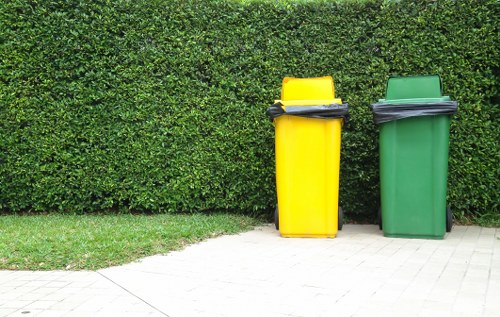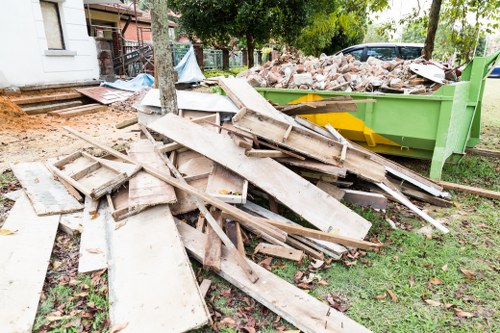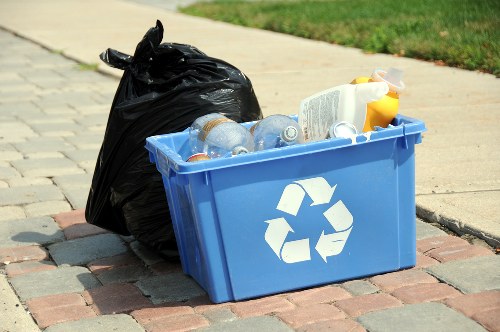Property Clearance in Commercial Waste Collection

Property clearance is a critical component of commercial waste collection, ensuring that businesses maintain a clean, safe, and compliant environment. Whether it's an office building, retail space, or industrial facility, effective property clearance involves the systematic removal of unwanted items, waste materials, and debris. This process not only enhances the aesthetic appeal of a property but also contributes to operational efficiency and environmental sustainability.
In the commercial sector, waste management is more complex compared to residential settings. The diversity of waste types, volume of materials, and regulatory requirements necessitate specialized property clearance services. Professional waste collectors provide tailored solutions that address the unique needs of businesses, helping them streamline their waste disposal processes and reduce their environmental footprint.
Understanding the intricacies of property clearance in commercial waste collection is essential for business owners and facility managers. It enables them to make informed decisions about waste management strategies, optimize resources, and comply with local and national regulations. This article delves into the various aspects of property clearance, highlighting its importance, processes, benefits, and best practices.
Importance of Efficient Property Clearance

Efficient property clearance is paramount for several reasons. Firstly, it ensures a clutter-free environment, which can significantly enhance the productivity and well-being of employees. A clean workspace reduces the risk of accidents, improves air quality, and creates a more pleasant atmosphere for both staff and visitors.
Secondly, proper waste management helps businesses comply with health and safety regulations. Failure to adhere to these standards can result in hefty fines, legal issues, and damage to the company's reputation. Efficient property clearance demonstrates a commitment to maintaining a safe and healthy workplace, which is vital for business continuity and success.
Moreover, effective property clearance contributes to environmental sustainability. By implementing responsible waste disposal practices, businesses can minimize their ecological impact, reduce landfill usage, and promote recycling and reuse of materials. This not only benefits the environment but also enhances the company's corporate social responsibility (CSR) profile.
Types of Commercial Waste in Property Clearance

Commercial waste encompasses a wide range of materials, each requiring specific handling and disposal methods. Understanding the types of waste generated is crucial for developing an effective property clearance strategy. Common categories include:
- General Waste: Everyday items that are non-recyclable and non-hazardous, such as paper, packaging materials, and food scraps.
- Recyclable Materials: Items that can be reprocessed and reused, including glass, metal, plastic, and certain types of paper.
- Hazardous Waste: Dangerous substances that require special handling, such as chemicals, batteries, and electronic waste.
- Construction and Demolition Waste: Debris generated from building projects, including concrete, wood, and metal scraps.
- Electronic Waste (E-Waste): Discarded electronic devices like computers, printers, and smartphones.
Each type of waste demands adherence to specific regulations and disposal protocols to ensure safety and environmental protection. Professional property clearance services are equipped to handle these diverse waste streams effectively.
The Property Clearance Process

The property clearance process involves several key steps designed to ensure thorough and efficient waste removal. These steps typically include:
- Assessment: Conducting a comprehensive evaluation of the property to identify the types and volumes of waste present.
- Planning: Developing a tailored clearance plan that outlines the methods, schedules, and resources required for waste removal.
- Segregation: Separating different types of waste to facilitate recycling, repurposing, or proper disposal.
- Collection: Gathering and transporting waste materials to designated disposal or recycling facilities.
- Recycling and Disposal: Processing recyclable materials and disposing of non-recyclable waste in compliance with environmental regulations.
- Final Inspection: Ensuring that the property is free of debris and that all waste has been appropriately handled.
Throughout the process, clear communication between the property owner, facility manager, and waste collection service provider is essential to ensure that all parties are aligned and that the clearance is executed smoothly.
Benefits of Professional Property Clearance Services

Engaging professional property clearance services offers numerous advantages for businesses:
- Expertise and Experience: Professionals possess the knowledge and skills required to handle various waste types efficiently and safely.
- Time and Cost Efficiency: Outsourcing waste collection allows businesses to focus on their core operations, saving time and reducing overhead costs associated with in-house waste management.
- Compliance Assurance: Professional services ensure that all waste disposal practices adhere to local and national regulations, mitigating the risk of legal issues.
- Environmental Responsibility: Experts implement sustainable waste management practices, promoting recycling and reducing the overall environmental impact.
- Customized Solutions: Property clearance services can be tailored to meet the specific needs and schedules of businesses, providing flexible and scalable solutions.
These benefits collectively contribute to a more organized, compliant, and environmentally conscious business operation.
Environmental Impact of Proper Waste Collection
Proper waste collection plays a significant role in environmental conservation. By effectively managing waste, businesses can reduce the strain on landfills, decrease pollution, and promote the reuse and recycling of materials. Key environmental benefits include:
- Reduction in Landfill Usage: Efficient waste clearance minimizes the volume of waste sent to landfills, prolonging their lifespan and reducing land use.
- Pollution Prevention: Proper disposal of hazardous and non-hazardous waste prevents soil, water, and air pollution, safeguarding ecosystems and public health.
- Resource Conservation: Recycling and repurposing materials conserve natural resources by reducing the need for raw material extraction.
- Energy Savings: Manufacturing products from recycled materials generally consumes less energy compared to producing them from virgin resources.
Adopting responsible waste management practices not only benefits the environment but also enhances a company's reputation as a socially responsible entity.
Choosing the Right Property Clearance Provider
Selecting an appropriate property clearance provider is crucial for ensuring effective waste management. Considerations when choosing a provider include:
- Experience and Expertise: Assess the provider's track record in handling commercial property clearance and their familiarity with various waste types.
- Services Offered: Ensure that the provider offers a comprehensive range of services, including waste segregation, recycling, and disposal.
- Compliance and Certifications: Verify that the company adheres to relevant regulations and holds necessary certifications for waste management.
- Reputation and Reviews: Research customer feedback and testimonials to gauge the provider's reliability and quality of service.
- Pricing Structure: Evaluate the cost-effectiveness of the services offered, ensuring transparency in pricing without hidden fees.
By carefully evaluating these factors, businesses can partner with a property clearance provider that aligns with their operational needs and sustainability goals.
Cost Factors in Commercial Waste Collection
The cost of commercial waste collection varies based on several factors. Understanding these cost determinants can help businesses budget effectively and choose the most economical solutions. Key cost factors include:
- Volume of Waste: The quantity of waste generated directly influences the cost, with higher volumes typically incurring higher fees.
- Type of Waste: Hazardous or specialized waste often requires more stringent handling and disposal methods, leading to increased costs.
- Frequency of Collection: Regular waste pickup services may be more cost-effective compared to one-time or sporadic collections.
- Distance to Disposal Sites: The proximity of waste disposal facilities affects transportation costs, with longer distances leading to higher expenses.
- Additional Services: Services such as on-site waste audits, recycling programs, and emergency clearances may incur extra charges.
Businesses should assess their waste generation patterns and specific needs to determine the most cost-efficient property clearance solutions.
Best Practices for Effective Property Clearance
Implementing best practices in property clearance ensures that waste management is efficient, compliant, and environmentally responsible. Key best practices include:
- Regular Waste Audits: Conduct periodic assessments to identify waste generation sources and opportunities for reduction or recycling.
- Waste Segregation: Separate different types of waste at the source to facilitate recycling and proper disposal.
- Employee Training: Educate staff on waste management protocols and the importance of minimizing waste.
- Sustainable Purchasing: Opt for eco-friendly products and packaging to reduce the overall waste footprint.
- Collaboration with Waste Providers: Work closely with property clearance services to develop tailored waste management strategies.
Adhering to these practices not only enhances the effectiveness of property clearance efforts but also supports broader sustainability objectives.
Future Trends in Property Clearance and Waste Collection

The landscape of property clearance and waste collection is evolving, driven by technological advancements and increasing emphasis on sustainability. Emerging trends include:
- Automation and AI: The use of automated systems and artificial intelligence can optimize waste sorting, collection routes, and resource allocation.
- Smart Waste Management: Integration of IoT devices for real-time monitoring of waste levels and predictive maintenance.
- Circular Economy Models: Emphasis on designing waste-out processes that promote reuse, recycling, and material recovery.
- Green Certifications: Growing demand for waste management services that meet international sustainability standards and certifications.
- Employee Engagement: Increased focus on involving employees in waste reduction initiatives and fostering a culture of sustainability.
Staying abreast of these trends enables businesses to adopt innovative waste management practices, enhancing efficiency and environmental stewardship.
Contact us today to learn how our professional property clearance services can help your business achieve effective and sustainable waste management solutions.